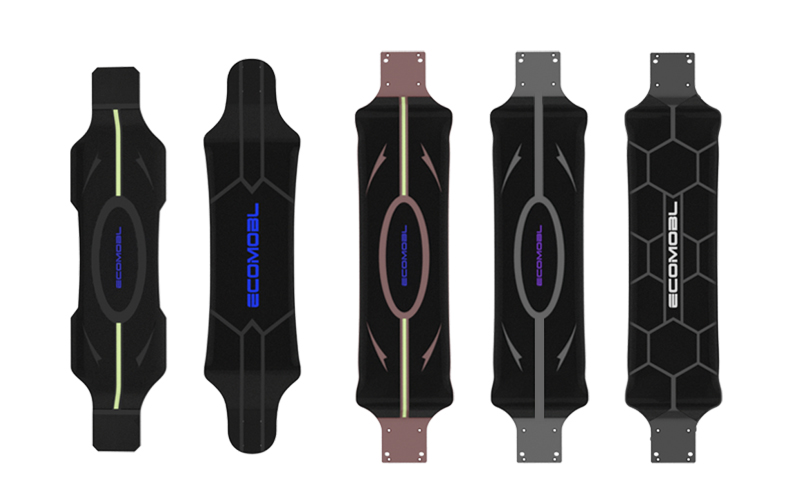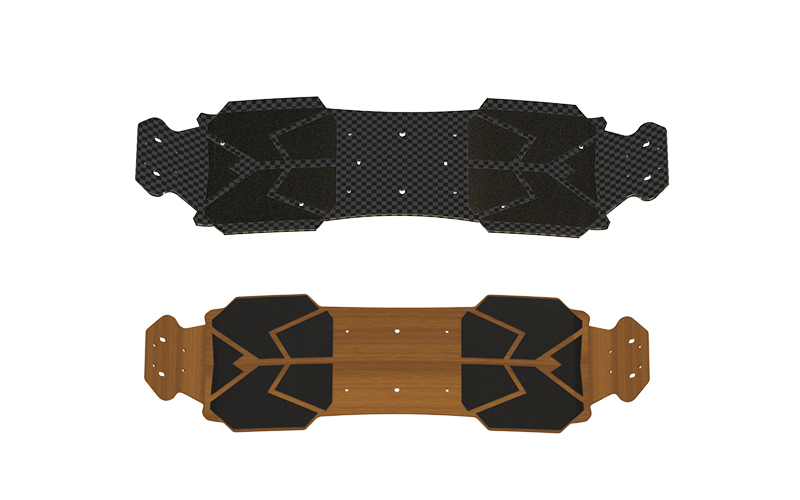Every electric skateboard ride starts with feel. The deck you stand on defines how it holds you in the carve, how it transfers power under load, and how it reacts when the pavement disappears under trail dust. This guide is for riders who think with their feet and build their setups from the ground up.
Why the Deck Is the Heart of Your Ride
Push off, lean in, brake hard, your deck translates every move. It’s where control begins and stability is decided. The way it responds under pressure, flexes under your stance, and transfers force to the wheels defines how your board rides, turns, and reacts.
1. Long vs. Short Decks: What the Length Tells You

The length of your deck affects everything from carving to carrying. Go long (37 inches and up), and you get stability, balanced weight, and smoother carving, perfect for speed and uneven ground. Paired with pneumatic tires, it’ll eat up the rough stuff with confidence.
Prefer quick turns and compact setups? A short deck gives you agility in traffic, easier portability, and fast directional changes. If you’re commuting, hopping trains, or squeezing through narrow streets, a short deck keeps you light and sharp.
But deck length isn’t the only thing shaping how your board feels. The way a deck curves and contours under your feet plays just as much of a role in handling and response.
2. Deck Shapes & Profiles: How They Impact the Ride
The shape you stand on influences how you stay locked in during turns. A concave deck (rounded edges) holds your soles and keeps you able to sink in tight when carving or braking. All-terrain boards prefer riding on deeper concaves as they make it possible to remain locked into bumps or to power out of turns.
Flat decks are looser-riding, with greater room to move your feet. That makes them ideal for cruising or extended trips where foot relief and comfort are more desirable than edge hold.
Deck profile also changes your relationship with the road:
- Camber bends up, giving you bounce and response ideal for bamboo designs and rhythm riders.
- Rocker lowers your center of gravity, offering greater control and shock absorption, especially when the road gets tricky.
- Convex decks (domed center) are rare and usually made for freestyle, not electric board-compatible.
Choose the shape that gives you the best foot-to-deck connection.
3. Materials Matter: From Maple to Carbon Fiber
What your deck is made of changes everything: how it bends under your stance, how it eats up vibration, and how it pushes back when torque hits hard. Materials shape the ride more than you think.
- Maple is the standard: strong, dense, and stable. If you want stiff control and solid feedback under acceleration, Maple’s dependable, even if it’s a bit heavy.
- Carbon fiber is for precision. Ultralight and ultra-rigid, a carbon fiber electric skateboard can transfer energy instantly and hold steady even when you’re riding hard over broken terrain.
- Composite decks blend materials to tune performance, rigid in the center, flexible where needed. If you want performance without sacrificing ride comfort, composites are your sweet spot.
Once you’ve dialed in the material and flex, it’s time to consider how the deck fits your body. Geometry controls how that energy translates into movement.
4. Deck Geometry: Width, Mounting Style, and Wheelbase
Your board’s geometry needs to be compatible with your stance and how you ride.
- Width controls comfort. If you’re riding fast or need added stability, 9–11 inches gives you space to move and brace. Narrower decks allow quicker turns but can feel tight after a long ride.
- Mounting style changes how you feel the board: Top mount raises your center of gravity and makes turning response faster. Drop-through lowers the deck and gives you a stable, solid feel perfect for long commutes or big batteries.
- Wheelbase has a greater effect on turning than deck length. The longer the wheelbase, the smoother the carving and stability. A short one will respond quicker, but can get nervous at high speeds.
Choose geometry that suits your riding style.
5. Match the Deck to Your Riding Style

The best deck isn’t the most expensive; it’s the one that matches how and where you ride.
- If you’re riding in the city, go for a deck with a flat or mellow concave. Maple with drop-through mounting gives you comfort and control during quick stops and starts.
- For trails or off-road, you need structure. Carbon or composite decks with concave shapes and low flex give you grip and consistency on uneven ground.
And if you ride a bit of everything, look for a hybrid deck that balances flex, control, and wheelbase adjustability. Build for your environment.
6. Flex and Feel: Balancing Feedback and Cushioning
Deck flex absorbs the ride but affects how your board talks back to you.
- Stiff decks give you a tight response and more efficient power delivery, ideal if you’re riding fast or using high-powered motors.
- Medium flex gives you some comfort on city roads and mixed terrain without losing control.
- Soft flex is for chill cruising, not performance.
Smart layering in carbon or composite builds can give you flex where you want it and stiffness where you need it. Pay attention to how your deck feels under load; it matters.
Of course, even the most finely tuned ride won’t last without care. Maintenance keeps your setup responsive, safe, and ready for the next session.
7. Maintaining Deck Performance Over Time
Keep your deck in shape, and it’ll carry you further. After a few rides, especially off-road, check for:
- Cracks around mounting holes
- Splinters or chips on the edges
- Soft spots or delamination around the enclosure
If you’re riding a wooden deck, seal it every few months and keep it dry. Even sealed decks can weaken with moisture or sunlight. Carbon and composites are tougher but still hate heat and UV stress.
Clean your grip tape. Store your board flat in a dry place away from trunks, garages, or humid basements.
8. Deck Mistakes You’ll Want to Avoid
Some choices look smart on paper but ride poorly in practice. Watch out for these:
- Choosing flex over control on high-speed setups
- Buying a long deck when you’re riding tight city streets
- Ignoring wheelbase, which directly impacts turning
- Using a flat deck on rugged terrain and losing foot grip
Don’t pick your deck based on looks or length alone. Pick the one that feels like an extension of your riding style.
9. Deck + Setup: Integration That Defines Performance
Your deck sets the tone, but it only works if it plays well with the rest of your setup.
- If you’re running high-torque motors, use carbon or composite decks with torsional stiffness.
- If you ride long distances, maple for comfort with flex.
Ecomobl has this integration dialed in:
- The Mini 2WD rocks a maple deck for tight urban maneuvering and responsive riding.
- The ET Pro features a robust 11-layer deck composed of 9-ply Canadian maple and 2 layers of fiberglass, a 12S3P battery, and dual 6000W gear motors engineered for high torque and versatile performance across both streets and trails.
Compared with the traditional maple deck, which is easy to crack, the maple deck with glass fiber has higher strength and durability.
In both cases, the ride starts at the deck and everything else builds around it.
Final Thought
Performance begins where your stance meets structure. A well-matched deck doesn’t just carry your weight, it responds to your motion, locks in your balance, and stays with you when the ride gets rough. If your style’s dialed in, your deck should be too. Find the board that rides like you do.
Want a setup that’s already optimized? Check out Ecomobl‘s deck-ready builds here.




